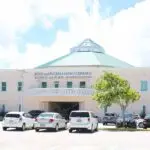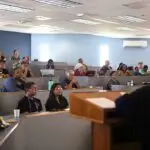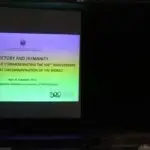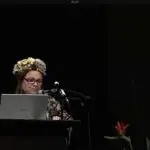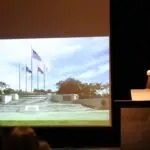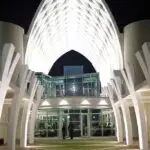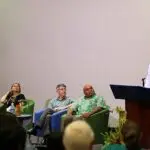4th Marianas History Conference
Table of Contents
Share This
Commemorating Our Histories
The fourth Marianas History Conference, “Commemorating Our Histories,” was held at the University of Guam from Saturday, 31 August – Sunday, 1 September 2019.
The Conference theme, One Archipelago, Many Stories: Commemorating Our Histories, is in honor of Our War Survivors as 2019 marked the 75th Anniversary of the end of the World War II in the Marianas and Liberation. It is in their memory and in their strength that we come together again as One Archipelago with Many Stories.
The conference also focused on plans to commemorate the upcoming 500th anniversary of Ferdinand Magellan’s visit to the Marianas in 2021.
Members of the steering committee included Dr. Michael Clement Jr., Dr. Mary Therese F. Cruz, Dr. Kenneth G. Kuper, Rita P. Nauta, Shannon J. Murphy, Dr. Carlos Madrid, Leo Pangelinan, Elyssa Santos, Natasha Suba, and Harmony Palaganas.
University of Guam student volunteers were Oscar Cabatic, Michaella Celorio, Nolan Flores, Prairie Garrido, Joseph Madlangbayan, Camille Masilungan, Erriu Mitchell, Aria Palaganas, Brendan Santos, Javan Santos, and Diandra Villanueva.
The Conference’s opening reception was held at the Latte of Freedom, Anigua. The proceedings were hosted by the University of Guam, Mangilao. Closing ceremonies took place at the Guam Museum, Hagåtña.
This conference was sponsored by the University of Guam, Sorensen Media Group, Newstalk K57, Power98, The Shark, KAT FM, Guam Preservation Trust, the Governor and Lt. Governor of Guam, Guampedia, Bank of Guam, UOG College of Liberal Arts and Social Sciences, and I Kumisión i Fino’ CHamoru yan i Fina’nå’guen i Historia yan Lin’la’ i Taotao Tåno.
Guampedia produced this e-publication. It is presented here in a series of three booklets. The first is the conference overview and schedule as well as the keynote presentation by Dr. Rene R Escalante and endnote by Dr. Carlos Madrid. The second booklet includes five presentations on CHamoru culture. The third booklet includes 13 presentations on Guam history.
Editor’s note: Not all of the presentations at the conference were submitted by the authors for this e-publication.
Paper titles and abstracts by e-publication
Overview
Freedom and Humanity
Keynote presentation
Freedom and Humanity: The Filipino Way of Commemorating the Quincentenary of the First Circumnavigation of the World
By Rene R. Escalante, PhD
In 2021, many countries in different continents will be commemorating the 500th anniversary of the first circumnavigation of the world by the Magellan-Elcano expedition. This is a great achievement of humanity that many people want to remember and draw inspiration and wisdom from. Most countries where the Magellan-Elcano anchored are preparing for a grand commemoration. One of them is the Philippines.
This paper will highlight that one of the tasks of history is to recognize and immortalize the achievements of people who have made significant contributions to the development of human knowledge about ourselves and of the world in which we live. Aside from presenting the context and the grand narrative of the circumnavigation, the commemoration will also underscore the values and principles that can be generated from this historic event. The perspective is Filipino but the themes that will be developed are universal and could be adopted by other countries as well. Specific events and projects the Philippine government is planning to undertake will be explained in detail. The paper ends with an invitation for all participants to join the grand commemoration of this great achievement of man. Read keynote address here.
Commemorating Our Histories
End note address
By Dr. Carlos Madrid
How does the history of the Mariana Islands reflect the globalization processes in which we are immersed? How does it relate to issues such political status, island sustainability, marine preservation, intercultural dialogue? The commemorations of WWII and the 500 years of the circumnavigation of the world are unique frameworks and platforms for debate, networking, and global visibility. In public celebrations, official commemorations, plaques, ceremonies and official protocols, history is being (re)presented in the Mariana Islands, and the History of the Mariana Islands is being (re)presented. Policies of historic memory are essential components of a projected historical discourse, beyond history books, academic articles, or documentaries. They can also be manipulated, distorted and ignored, for political purposes, or for economic interests.
By bringing our own narratives of history into the public domain, we are actively constructing our sense of community, and simultaneously, presenting to the wide world the living voice of our generation. Read closing remarks here.
Culture
Ancestral Secret
Ancestral Secret: Discovering an Elusive Angle in the Sacred Geometry of the Sakman
By Mario R. Borja
Building a canoe does not make you a sailor; but it sure can help. This is about the discovery of an angle we stumbled upon in our quest to build the sakman, a single-outrigger canoe our Chamorro ancestors once built and sailed nearly three centuries ago. It starts with our curiosity about canoes once used to travel from one island to another. Our research led us to uncover more details of our own elusive seafaring history that would provide the data to begin our canoe project. One discovery after another has brought us to Guam with the canoe we have built. It was here in Hagåtña Bay that we discovered the purpose of an embedded angle that lay beneath our feet, an angle we constructed following ancestral design, an angle that would teach us how to sail the sakman. Read paper here.
Remembering Father Jesus Baza Duenas Through Oral Histories
By Judy S. Flores and William “Bill” M. Paulino
Father Jesus Baza Duenas was an important model of courage, persistence in faith and resistance to the Japanese during their occupation of Guam from 1941 to 1944.
The people of Inarajan retain a significant body of knowledge about Father Duenas, some of which has been recorded in personal journals by village historians. 2019 being the 75th anniversary of his death, it is especially important to mark this passage with a compilation of stories that contribute to our knowledge about him. As these stories unfold, we begin to get a sense of the personhood of this man, his courage to be true to his faith, to protect and comfort his parish community, and to use his position and resources to keep communications flowing among local underground resistance members. Through sharing of this collected knowledge, we can perhaps encourage small-group discussion and the collection of additional stories. Our goal in this endeavor is to provide a written archive of the activities and achievements as recalled and commented on by those who knew and observed him. Moreover, it is hoped that the collected knowledge can lead to the beatification of Guam’s own hero and martyr. Read paper here.
Digital Cultural Preservation of the Mariana Islands Through Collaborative Storytelling
By Sylvia C. Frain and Jim Marbrook
As researchers and filmmakers, we strive for digital cultural preservation through the combination of Oceanic knowledge(s) and new technologies. Our aim is to collaboratively develop digital storytelling methods and document moving images of culture and audio recordings of oral histories of the Marianas Archipelago. Conceptualized as a form of digital participatory action research, our approach includes the communities’ input and vision at every stage to record the forms of knowledge(s) which they deem important for future generations. Our contribution is through technical knowledge and filmmaking expertise combined with access to professional filming equipment and informs our new media research. Visual and audio data collection may include multigenerational interviews, aerial perspectives, drone footage, as well as underwater shots. The intended outcome is to create a Marianas methodology of cultural preservation for digital dissemination and accessible archives across new media platforms. View presentation slides here.
An Assessment of Preserving Latte Sites
By Dave Lotz
Destruction of latte sites began with colonialism, commencing with the Spanish who slaughtered the population while destroying villages, followed by the Japanese with the agricultural clearing of the broad terraces for sugar cane on Saipan, Tinian, Aguijan, and Rota. Last, the Americans furthered destruction with militarization, both by war and by construction of military facilities; and Westernization with rapid urbanization and population growth. This presentation will: provide an overview of the state of preserving the island’s latte – the most visible component of the heritage from the CHamoru legacy – and suggest ways in which the National Park Service could help preserve latte cultural landscapes. Read paper here.
Prubido Fumino’ Chamoru (On The Dangers Of Speaking Chamoru)
By Peter R. Onedera
A two by four ply board sign with red lettered text hung from the ceiling of the hallway of my village elementary school. It read “Prubido Fumino’ Chamorro,” when I entered the first grade. That sign was among three or four more spread throughout the campus and it stayed put as a reminder to us village children for the rest of our elementary years.
I felt lost. That sign meted punishment after punishment in those early years. I was educated into thinking that CHamoru was a nothing and a waste of time. Other CHamorus, starting with the teachers, bought into it and it was to be a tremendous embarrassment with reminders and constant reprimands to not speak the language I grew up with.
That feeling is still there today. Read paper here.
Spanish Era
CHamoru “Adaptive Resistance” during the Spanish Conquest and Colonization of the Marianas Islands
By David Atienza, PhD
Mainstream history of the Mariana Islands presents the CHamoru as indigenous people who were transformed after the conquest (1668–1700) into a Hispanicized population losing their Austronesian cultural tradition. I instead emphasize the role of CHamorus during these years as active participants in their history and vehicles of what I call “adaptive resistance.” In this paper I present some of the ideological interpretations that have been included in the historical narrative. They have been accepted without conducting a critical analysis of the sources and have been crucial to establish this narrative. Read paper here.
Ferdinand Magellan (Fernão de Magalhães in Portuguese and Fernando de Magallanes in Spanish) Memoria
By Omaira Brunal-Perry
Ferdinand Magellan (c. 1480-1521) set out from Spain in 1519 with a fleet of five ships to discover a western sea route to the Spice Islands. This presentation is based on the facts of Magellan’s life and character researched by Historian José Toribio Medina and published in Santiago de Chile in 1920. The work of J.T. Medina is so monumental that it has guided the study of many historians. In this paper the author is selecting passages of Magellan’s Memoria and translating them to illustrate his ambition and goals of the expedition that change navigation forever. View presentation slides here.
Garrison Folks and Reducciones
Garrison Folks and Reducciones: Bifurcating the Hagåtña Narrative in 18th Century Marianas History
By Michael Clement, Jr.
Census data from 18th century Guam and Rota paints a picture of a segregated society in which different segments of the Chamorro population had radically different life experiences. The most obvious distinction was that between the ethnically mixed community of Agadña and the more homogenous indigenous communities of the surrounding barrios and rural villages. This presentation examines ways a dominant “Hagåtña narrative” obscures these differences. Utilizing Prasenjit Duara’s critique of nationalist history, I argue that a “bifurcated” history of the 18th century Chamorro experience brings greater understanding to processes of political and cultural continuity and change during these years. Read paper here.
The Archaeological Remains of Early Spanish Colonialism on Guam
By Boyd Dixon, PhD, Andrea Jalandoni, PhD, and Cacilie Craft, MA
The historical record of Early Modern Spanish Colonialism on Guam is reasonably well detailed when using primary and secondary literature to reconstruct significant events, policies, and personalities that affected the general population from 1521 to 1700. It is however, biased from the perspective of the only witnesses who could leave a written record at the time – early maritime chroniclers, later Jesuit priests, and eventual colonial administrators. The historical record of what exactly was exchanged between Spanish clergy or government officials, Philippine or Mexican military, and Chamorro inhabitants is far less explicit in the literature. This vacuum, if indeed it can be partially filled by archaeological inquiry, is the topic of this paper. Read paper here.
Deconstructing Pigafetta’s Account of First Contact
By Frank Quimby
Antonio Pigafetta’s narrative of Magellan’s circumnavigation has been the primary source for all subsequent accounts of this seminal event in world history. Unfortunately, his pejorative description of the expedition’s March 7-9, 1521, visit to Guam has been uncritically accepted and generally repeated in most histories of this historic first meeting of Pacific Islanders and Europeans. Other eyewitness accounts of the expedition’s visit differ substantially from Pigafetta’s Guam narrative, offering an alternative view of this meeting. Moreover, the pervasive pro-Magellan bias guiding Pigafetta’s selection and interpretation of the circumnavigation’s significant events underscores the need for a critical approach to his depiction of Chamorro interaction with the expedition. This article attempts to place Pigafetta’s account of the Guam visit in the larger context of the expedition’s politics and his Boswellian view of Magellan and to suggest why he chose to cast the encounter in such a stereotypically negative light. Read paper here.
US Naval Era
Settler Insurgents
Settler Insurgents: Filipino Exiles and the 1901 Chamorro Petition
By Kristin Oberiano
his presentation will historicize Filipino revolutionary hero Apolinario Mabini’s incarceration on Guåhan from 1901-1903, and the simultaneous drafting and petitioning for a civilian Guamanian government by Chamorro elite in 1901. Guåhan’s role as a penal colony demonstrates the transition of Spanish and American imperial regimes. During the Philippine Revolution, the United States deported Filipino revolutionaries to Guåhan. Meanwhile, the Chamorro people of Guåhan sent the first petition for a civilian government in 1901. Some of the signers had direct relationships with Mabini. We can only speculate if they discussed American colonialism in the Philippines and Guåhan, if they made plans to aid each other’s anti-colonial struggles, or if they were silenced by the guards standing outside the prison. Yet, that they did meet disrupts notions of the completeness of imperial power, and shows how even in spaces of dominance and incarceration, there can be, too, places of resistance. Read paper here.
Recent History
An Gumupu Sakman (When the Proa Flies)
An Gumupu Sakman (When the Proa Flies): History of the Chamorro Sakman
By Arthur A. De Oro
The one Chamorro technological achievement that was revered by European explorers of the 16th through 18th centuries was the Chamorro flying proa or sakman. From Magellan’s first sighting of the Marianas to Anson’s drawings of 1742, the sakman was regarded as the Ferrari or Porsche of the sailing world. It was a thing of beauty, speed, and craftsmanship. Chamorros were highly regarded as expert boat builders, sailors and fishermen. That knowledge, skill and innovation was nearly lost when colonization of the Marianas was complete. Fast-forward to the 21st century to find the Chamorro renaissance of the celebrated sakman. 500 Sails, a Saipan based non-profit organization is writing a complete history of the sailing traditions of the Marianas. It includes European accounts, a Chamorro lexicon of nautical terms and parts of the sakman, a sailing curriculum, and the people and organizations that are leading the revival of the Chamorro flying proa. View presentation slides here: https://issuu.com/guampedia/docs/history_all/131
Lessons from Lesser Laguas – Stories of Aguiguan
By Moñeka De Oro
The four main islands of the Marianas are all located in the southern end of the archipelago. Together Rota, Saipan, Tinian, and Guåhan and the lone uninhabited island of Aguiguan/Aguijan make the “Låguas” portion of the Marianas. All islands north of Saipan collectively create “Gåni.” This presentation will provide vignettes of history focusing on Aguiguan. There are so many significant historical and ecological stories that are not widely shared about Aguiguan. For example, Aguiguan island is the location of one of the last major battles in the Chamorro-Spanish Wars. Aguiguan is also the only place where the endangered Marianas Sheath Bat and countless other plant and animal species still exist today. Commonly referred to as “goat island”, there is so much more to know about this island than the invasive goats that inhabit it today. View presentation slides here.
The Japanese Migration to Guam and Legacy of Kazuji Shimizu
By Monica Okada Guzman and Frank SN Shimizu
On May 3rd, 1868 a British ship left Japan bound for Guam. Aboard were 43 individuals who ranged in age from teens to adults. On June 8th, 1868 they arrived in Agaña as the first Japanese immigrants to Guam. In the late-1800’s 53 Japanese individuals settled in Guam, assimilating to the culture and intermarrying. Their CHamoru-Japanese descendants include prominent figures in the island.
Although a majority of these descendants have lost touch with their Japanese families, there is a desire to rekindle these familial relationships and to become reacquainted with their Japanese heritage. The Guam Nikkei Association provides an avenue for this connection. The legacy of Kazuji Shimizu lives on in the family and business enterprises that have contributed to Guam’s economy and furthering Japanese American CHamoru ties. This presentation will focus on migration to Guam, the Guam Nikkei Association, and the contributions of the Japanese-CHamoru family of Kazuji Shimizu. View presentation slides here.
I Maga'taotao Siha
I Maga’taotao Siha: The Elders Who Inspire Us to Decolonize
By Victoria-Lola Leon Guerrero and Monaeka Flores
At each General Assembly, Independent Guåhan honors a maga’taotao: a hero or notable figure that has helped guide the island and the CHamoru people on their quest for self-determination. Independent Guåhan draws from a diverse array of CHamoru leaders and community members, highlighting the historic and political context that informed or provoked their wisdom and work to further broaden or complicate conversations about self-determination. Family members of each maga’taotao share their insight and reflect on the lives and contributions of each individual. A wide range of critical issues are examined and demystified through their stories including environmental stewardship, political autonomy, protection of historic and cultural resources, economic development, land use, sustainable agriculture, security, CHamoru language advocacy, education, CHamoru identity and survivorship to name a few. This presentation will highlight the maga’taotao celebrated in the Independent Guahån series and the important roles they have played in the progress of our people. Read paper here.
Our Hispanic Heritage
Our Hispanic Heritage: The Key to Broadening Chamorro Cultural Awareness
By Clark Limtiaco
We Chamorros are no strangers to our Hispanic heritage. Or are we?
Many of us view the Spanish influence as something circumstantial and superficial, unaware that many Chamorro customs and traditions have deep Hispanic roots. As Chamorros, we too, form part of the Hispanic cultural realm. In spite of heavy Americanization, our culture remains deeply Hispanic. Each time we shout, “Biba Chamorro,” our Hispanic heritage comes alive.
Still, the Marianas continues to be ignored by most scholars in both Spain and Mexico. Our Hispanic heritage can be a powerful tool to connect us with the custodians of most of our written history. Promoting Spanish language ability will allow our native scholars to collaborate directly with their Spanish speaking counterparts, further advancing Marianas history scholarship. Participation by native Chamorro scholars in history conferences and Hispanic cultural events (in Spain, Mexico, etc.) will stimulate interest and will widen Marianas/Chamorro awareness beyond Oceania. Read paper here: https://issuu.com/guampedia/docs/history_all/197
An Internalized Identity
An Internalized Identity: Gendered Narratives of Militarism and Tourism in Guåhan
By Hannah Villagomez Sablan
This paper will discuss the gendered narratives of militarism and tourism throughout Guåhan’s colonial history and how they have been internalized and perpetuated under American rule. These narratives were forced upon the CHamoru people and have emasculated them into a position of inferiority and sacrificial hospitality that serves the interests of the US military and tourism industry. This new collective identity works against efforts of decolonization with status quo and integration continuing to be the preferred options of self-determination. Dependency goes beyond finances and security – it is psychological too. To counter the colonial canon, certain questions must be asked: What qualities do the CHamoru people possess outside of what they provide and need from militarism and tourism? How have they remained masculine despite the narrative that they have been emasculated? A counter narrative already exists and must be remembered and embraced to move forward in empowerment. Read paper here.
African-American Influence in Guam History
African-American Influence in Guam History: Parallels and Intersections
By Carla Smith
During an interview on March 27, 2015, Dr. Robert Underwood, stated, “The most salient example that you have to draw from American society about anything that has racial or ethnic dimensions or issues related to discrimination or unfair treatment is almost always rooted in the African American experience. … That’s what makes the African American experience so powerful.” Accordingly, in this presentation, we will examine how the African American experiences of slavery and segregation provided the historical framework for the colonization of the Chamorros under the American administration. We will also discuss the intersections of African American and Chamorro struggles from the early twentieth century throughout the civil rights/decolonization movements. Finally, this presentation will encourage scholars to think outside the box and expand the analysis through which local issues are investigated. View presentation slides here.

